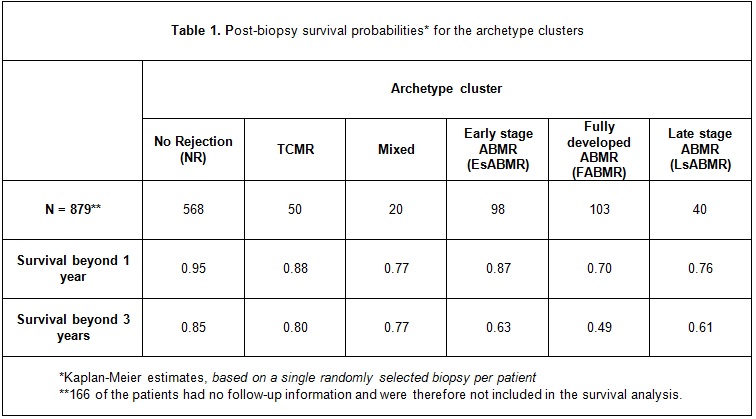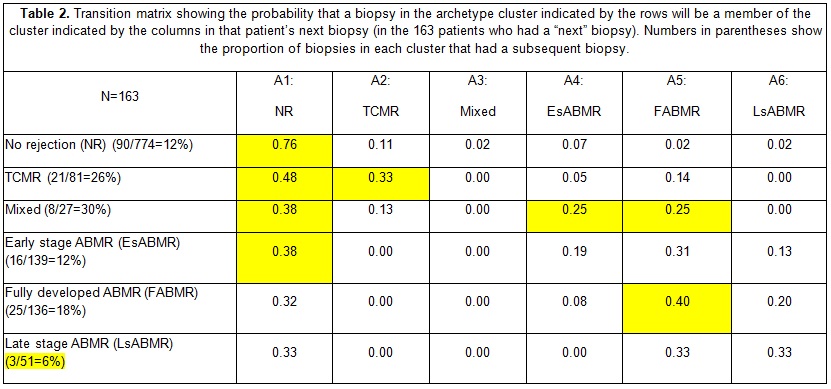The Natural History of Kidney Rejection: How Do Molecular Disease States Change Over Time in Patients with Repeat Indication Biopsies?
University of Alberta, Edmonton, AB, Canada
Meeting: 2017 American Transplant Congress
Abstract number: 300
Keywords: Gene expression, Kidney, Rejection, Survival
Session Information
Session Name: Concurrent Session: Antibody Mediated Rejection in Kidney Transplant Recipients: Pathophsiology and Epidimiology
Session Type: Concurrent Session
Date: Monday, May 1, 2017
Session Time: 4:30pm-6:00pm
 Presentation Time: 5:18pm-5:30pm
Presentation Time: 5:18pm-5:30pm
Location: E354a
Molecular phenotypes are highly reproducible, but how do they evolve over time? In an unsupervised microarray analysis, 1208 kidney transplant biopsies were assigned to one of six phenotype clusters using archetype analysis – 1) No rejection(NR); 2) TCMR; 3) Mixed; 4) Early stage ABMR (EsABMR); 5) Fully developed ABMR (FABMR); and 6) Late stage ABMR (LsABMR). Graft survival was highest in NR and TCMR, but even the two highest-risk clusters (FABMR and LsABMR) had a ~50-60% probability of surviving to 3 years post-bx (3YSrv) (Table 1).
We examined shifts in cluster membership in the subset of 131 patients who had more than 1 indication biopsy, resulting in 163 “follow-ups”, to see how stable the phenotypes were over time. This provides an indication of the natural history of molecular rejection. Table 2 shows the probability of shifting from one molecular phenotype cluster to another in the patient's “next” biopsy.
NR repeated as NR in 76% of subsequent biopsies, but 13% shifted to ABMR(any)/Mixed and 3YSrv was 85%. TCMR had the best recovery rate, usually repeating as NR or TCMR, but 19% transitioned to ABMR, and 3YSrv was down to 80%. Mixed repeated as ABMR in 50%, and had a 77% 3YSrv. EsABMR often repeated as NR but more often evolved to FABMR/LsABMR, and had a 63% 3YSrv. FABMR usually repeated as FABMR or LsABMR, but 33% recovered to NR. It had the lowest 3YSrv of any cluster, at 49%. LsABMR was seldom re-biopsied, and 3YSrv was 61%.
The results suggest that there is general trend for progression over time from EsABMR to FABMR to LsABMR. However, both EsABMR and FABMR have the potential to remit, and have a ~55% chance of surviving to at least three years post-biopsy, which should encourage continuing efforts at treatment. Even fully developed ABMR is not hopeless. 

CITATION INFORMATION: Reeve J, Halloran P. The Natural History of Kidney Rejection: How Do Molecular Disease States Change Over Time in Patients with Repeat Indication Biopsies? Am J Transplant. 2017;17 (suppl 3).
To cite this abstract in AMA style:
Reeve J, Halloran P. The Natural History of Kidney Rejection: How Do Molecular Disease States Change Over Time in Patients with Repeat Indication Biopsies? [abstract]. Am J Transplant. 2017; 17 (suppl 3). https://atcmeetingabstracts.com/abstract/the-natural-history-of-kidney-rejection-how-do-molecular-disease-states-change-over-time-in-patients-with-repeat-indication-biopsies/. Accessed December 14, 2025.« Back to 2017 American Transplant Congress
